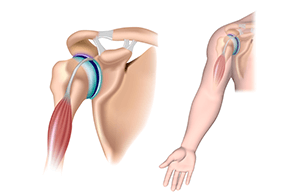
Not only must employers be accommodating for employees with existing musculoskeletal conditions, they must also take preventative measures so that conditions aren’t caused at work. One study, carried out by the HSE (Health and Safety Executive in Great Britain), discovered that 507,000 workers suffered from a work-related musculoskeletal disorder (new or long-standing) in 2016/17.
In fact, according to the NHS website, musculoskeletal conditions affect the joints, bones and muscles and also include rarer autoimmune diseases and back pain. Unfortunately, many of the adult population are affected by these sorts of conditions and this can massively impact their quality of life. Employers must therefore consider how their own staff are affected by these sorts of conditions and what they can do to help.
With this in mind, just how can employers support their staff with musculoskeletal disorders? And, what preventative action can they take to stop these types of disorders developing? Read on as we explore the issues further.
How can Musculoskeletal disorders affect employment????
One in four of the UK adult population are affected by musculoskeletal disorders. Unsurprisingly, those with musculoskeletal conditions struggle with full attendance — resulting in periods of absenteeism. In fact, 30 million working days were lost due to these conditions in 2016 which can be costly for employers. Based on calculations that consider the average UK salary and a working day of 7.5 hours, an individual sick day can cost an employer £107.85 if the worker receives full sick pay. There is also the cost of work being covered, perhaps this is by another employee who then can’t do their own work.
Based on data gathered in 2016/17, 45% of musculoskeletal disorders are to do with the upper limbs or neck, 38% to do with the back, and 17% involve the lower limbs. Out of sufferers within working age (16-64), 59.4% are employed. There is a downward trend of musculoskeletal disorders per 100,000 from 2001 to 2017, but it’s still an issue that must be considered.
How can you help those suffering?
What can employers do to make work more enjoyable for these employees? And potentially reduce the number of sick days taken? It’s no surprise that due to the number of people that suffer with musculoskeletal conditions, it’s almost guaranteed that employers will have to accommodate for a member of staff who suffer with the disorder.
Is working from home an option?
The commute to and from work can be difficult for those who experience musculoskeletal pain as getting in and out of a vehicle or riding public transport can be painful. Instead, employees can stay at home where they may feel more comfortable and get on with their work — reducing lost productivity time that may occur if they come into work.
In addition to this, being able to work from home allows these employees to attend regular rehabilitation or physio therapy appointments and make up for the lost hours in their own time, at home. Perhaps their rehabilitation centre is closer to home than it is for work, and less time may be spent getting to and from their sessions than if they were travelling from the company.
Presenteeism is where employees come to work but with difficult or reduced efficiency and productivity due to them not feeling fully fit to work. 39% of public sector workers and 26% of private sector workers have experienced this in their own workplace according to the ONS (Office for National Statistics). Presenteeism often occurs because an employee is afraid to call in sick out of fear of being penalised by their employer. One way to address this for sufferers of musculoskeletal disorders is to provide them with the option to work from home.
The use of specialist equipment
Asking employees if they require specialist equipment at work is another way to improve their comfort and reduce the risk of absenteeism, or further injuries. Examples of these include:
· Ergonomic keyboard — These are designed to reduce muscle strain and should be offered to employees. For sufferers of musculoskeletal disorders, tasks that may be easy for some such as using a keyboard, mouse or pen can be difficult for someone who suffers with repetitive strain injury for example. Those with arthritis and carpal tunnel syndrome may also struggle with these types of tasks.
· Sitting or standing desks — Giving employees the option of a sitting or standing desk is one way to help. For some, standing upright may be more comfortable than sitting in the same position for a prolonged period.
· Lifting assistance — Where lifting is required as part of the job, offering assistance with heavy lifting can be helpful. A trolley for example can help employees transport objects that they might be struggling with. This may relieve joint pain for example and can help prevent further injury and strain.
· Other equipment — By talking to employees, company bosses can find out about other types of specialist equipment that could be helpful — tailored to each person and their needs.
What therapy is there available?
Offering complementary therapy at work can also be helpful for those suffering from musculoskeletal conditions. It could be something that employers could fund or offer to the full workforce.
Yoga is a complementary therapy that has been found to help with musculoskeletal pain. There are many ways that employers could encourage their workers to participate in this exercise — through organised classes within break times or after work, or through funding the classes. Although expensive, it’s possible that this extra exercise will help manage pain levels and reduce sick days.
Ensuring that all employees have someone to talk to if they are feeling under pressure is important and encouraging positive energy throughout the workforce with social events can also help. If employees are feeling extra stress, it could be worth looking into hiring extra staff or referring workers for therapy for example.
Regardless of your business, keeping stress and anxiety levels at a minimal is important in the workplace – added stress can increase pain levels and deter all employees from coming to work. There is a clear link between musculoskeletal disorders, mental health and work loss. In fact, depression is four times more common amongst people in persistent pain compared to those without pain.
What methods of support are there available?
Offering overall support and making all workers feel valued in the workplace is important. What else can employers do to retain staff with musculoskeletal disorders?
· Recognising and being aware of the conditions early on — If an employee has recently been diagnosed with a musculoskeletal issue, they should be encouraged to tell their employer as soon as possible. This allows for the company to intervene early and get the measures in place that will encourage the employee to return to work as soon as they can.
· Creating a ‘return-to-work’ programme — For those who have sustained an injury, creating a phased return could be beneficial for them. This reduces the risk of them taking a long period of sick leave through appropriate adjustments in their working environment.
· Promote good communication inside and outside of the workplace — Employers should take time to learn about each of their employees and their issues. This way, appropriate changes can be made at work which can encourage workers to come to their boss with problems and suggestions.
Preventative measures
Preventative measures mainly involve being aware of the potential triggers of musculoskeletal disorders in each organisation. Employers should encourage their staff to take breaks or move away from their workstations frequently (at least once every hour).
It is reported that 507,000 workers suffered from work-related musculoskeletal disorders (WRMSDs) (new or long-standing) in 2016/17. Because of this, 8.9 million working days were lost to WRMSDs in the UK in this time period — accounting for 35% of all working days lost.
Understandably, some industries have higher than average rates of musculoskeletal disorders because of the nature of the job; these are construction, agriculture, forestry and fishing, and transportation and storage. Research also found that WRMSDs are more prevalent in males.
The research above highlights that as well as having to accommodate for staff with existing musculoskeletal disorders, it’s also important for companies to have preventative measures in place to stop new injuries from occurring or existing strains to worsen.
Some WRMSDs are associated with certain work patterns that employees should e aware of, these include:
· The repletion of the same movements.
· Forced concentration on small parts of the body such as the hands or the wrist.
· Working without sufficient recovery between movements.
· Fixed or constrained body positions.
Employers must take action to help employees through specialist equipment, the option of working from home, and potentially funding complementary therapy. They should also recognise if their employees are at risk of WRMSDs and take appropriate preventative measures.






























